We have selected 10 of the most stunning and historic head sparklers worn by European royal brides. These classic toppers have a long and fascinating history in the European royalty, and have been worn on other royal occasions. other than weddings.
1. The Khedive of Egypt Tiara - Our top choice is this classic heirloom made by Cartier. It has a heartwarming story attached to its creation. It was commissioned by the Khedive of Egypt as a wedding gift to Princess Margaret of Connaught (granddaughter of Queen Victoria) for her wedding to Prince Adolf Gustaf of Sweden in 1905.
This tiara has a sentimental value because it was in Cairo, Egypt, that Princess Margaret and the future Swedish king fell in love. The Swedish prince immediately proposed to the princess during that special meeting. And married the same year. Pretty fast!
It was not worn by Princess Margaret on her wedding day, however, it became one of her favorite tiaras during her short tenure as Crown Princess of Sweden. It can be worn in many ways, either as a topper or as a garment ornament.
When she died in 1920 at the age of 38, this tiara was inherited by her only daughter, Princess Ingrid, together with her wedding veil. Ingrid became Queen Consort of Denmark in 1947 as the wife of King Frederik IX of Denmark.
All her three daughters wore it to their respective weddings. Princess Anne-Marie for her wedding to King Constantine II of Greece in 1964, Princess Margrethe (now Queen Margrethe II) for her wedding to Henri de Laborde de Monpezat in 1967, and Princess Benedikte for her wedding to Prince Richard of Sayn-Wittgenstein-Berleburg in 1968.
Queen Ingrid also loaned it to her three granddaughters at their weddings, Princess Natalie and Princess Alexandra of Sayn-Wittgenstein-Berleburg (daughters of Princess Benedikte), and Princess Alexia of Greece and Denmark (daughter of Queen Anne-Marie).
When Queen Ingrid died in 2000, the tiara was inherited by her youngest daughter, Queen Anne-Marie of Greece.
2. The Cameo Tiara - First worn by Princess Birgitta of Sweden for her wedding to Prince Johann Georg Hohenzollern in 1961, followed by Princess Desiree for her wedding to Baron Nils-August Silfverschiold in 1964. Then by Silvia Sommerlath for her wedding to King Carl XVI Gustaf of Sweden in 1976, and Crown Princess Victoria of Sweden for her wedding to Daniel Westling, in 2010.
The design of this tiara is one of the most intricate and elaborate among all royal tiaras we have seen so far in European royalty. And it has also a rich history to go with it.
Most royal researchers believed this tiara originally belonged to Empress Josephine, the wife of Napoleon Bonaparte of France. According to an article in The Court Jeweller, Though Empress Josephine did not have children with Emperor Napoleon, she had two children, Eugene and Hortense, from her first marriage to a French aristocrat.
The Cameo Tiara was inherited by her son, Eugene, who married Princess Augusta of Bavaria. He was made Duke of Leuchtenberg by his father-in-law, King Maximilian I of Bavaria.
Eugene and Augusta's eldest daughter, Josephine, married Crown Prince Oscar of Sweden and Norway in 1823 and became King and Queen of Sweden and Norway in 1844. It was believed the Cameo Tiara was given by the Duke and Duchess of Leuchtenberg to their daughter as a wedding present.
The tiara was inherited by Queen Josephine's daughter, Princess Eugenie, who did not marry. She bequeathed it to her nephew, Prince Eugen, who also did not marry.
Finally, in 1932, Prince Eugen gave it as a wedding present to Princess Sibylla of Saxe-Coburg and Gotha, the bride of his nephew, Prince Gustaf Adolf, Duke of Vasterbotten. They were the parents of the reigning Swedish monarch, King Carl XVI Gustaf.
Princess Sibylla loaned it to her two daughters during their respective weddings, Princess Birgitta in 1961, and Princess Desiree in 1964. In 1972, just a year before her son became Swedish king, she died from cancer. The Cameo Tiara was inherited by her only son who ascended the Swedish throne in 1973, King Carl XVI Gustaf.
This tiara featured gold, diamond, and pearls interspersed between the cameos. It has delicate feathering and small graduated seed pearls. The complex design depicted some mythical elements and neoclassical portraits. The central cameo represents a scene from the myth of Cupid and Psyche.
Today, Queen Silvia continues to wear the tiara on state occasions and during official portraits.
3. Queen Mary Diamond Fringe Tiara - At least three royal blood princesses wore this classic tiara on their respective wedding days. Princess Elizabeth in 1947, Princess Anne in 1973 (for her first marriage to Captain Mark Phillips), and Princess Beatrice of York in 2020.
With so many identical diamond fringe tiaras in the extensive jewelry collection of Queen Elizabeth II, this tiara is often confused with the George III Fringe Tiara or the Queen Alexandra Fringe Kokoshnik Tiara.
Actually, this is a different tiara. And the newest and the neater version among all the diamond fringe tiaras in the British royal jewelry collection. It was created for Queen Mary, the consort of King George V, in 1919 by Garrard and made of diamonds set in gold and silver.
According to The Court Jeweller, this tiara was made from the necklace made by Collingwood that Queen Victoria gave to then-Princess Mary of Teck as a wedding gift in 1893. Queen Mary dismantled the necklace and re-used the diamonds to make this fringe tiara.
This is one of the favorite tiaras of Queen Elizabeth II, she wore it often on many state occasions and official portraits. Mattell, an American toy manufacturer, used the image of this tiara when they designed the Barbie doll version of the Queen to mark her Platinum Jubilee year.
Queen Mary loaned the tiara to then Princess Elizabeth for her wedding to Prince Philip on November 20, 1947. The Queen inherited the tiara in 1953 upon the death of Queen Mary. She loaned it to her only daughter, Princess Anne, in 1973, then to her granddaughter, Princess Beatrice of York, on July 17, 2020.
4. The Prussian Tiara - The tiara worn by Princess Viktoria Louise of Prussia for her wedding to Prince Ernst August of Hanover, Duke of Brunswick, in 1913, by Princess Sophia of Greece and Denmark for her wedding to then Prince Juan Carlos of Spain in 1962, then by Letizia Rocasolano Ortiz when she married Prince Felipe in 2004.
One of the most historic tiaras worn by royal brides, the Prussian Tiara was created by the German court jeweler, Koch, for Princess Viktoria Louise, the only daughter of German Emperor, William II, for her wedding.
What made the marriage historic was that it united two former warring German royal houses - the Hohenzollern/Prussia and the Hanover. The bride and groom, however, were both direct descendants of King George III of the United Kingdom.
When their only daughter, Princess Frederica, married the future King Paul of Greece, in 1938, they gave the Prussian Tiara as a wedding gift, which became part of the Greek royal jewelry collection.
It's also interesting to note that Princess Frederica and Prince Paul, who became King and Queen of Greece in 1947, months before the wedding of his first cousin, Prince Philip, to Princess Elizabeth, were first cousins once removed through Queen Victoria of the United Kingdom (Paul's mother was Queen Sophia, the sister of Emperor William II of Germany), and second cousins through King Christian IX of Denmark.
When their eldest child, Princess Sophia, married the future King Juan Carlos of Spain, in 1962, they gave the tiara as a wedding gift, which is why this tiara of German origin is now part of the Spanish jewelry collection. In 1975, Juan Carlos ascended the Spanish throne upon the death of Spanish dictator, Francisco Franco.
Queen Sofia loaned the tiara to her son's bride, Letizia, on May 22, 2004. The Prussian Tiara was often worn on separate occasions by Queen Sofia's two daughters, Infanta Elena and Infanta Cristina.
It is not known, however, if it remains in her collection after King Juan Carlos abdicated in 2014. The current Spanish Queen Consort, Letizia, often wore it on state occasions.
5. The Vladimir Diamond Fringe Tiara - Most digital media and magazine outlets made an erroneous report on the tiara worn by Princess Marina of Greece and Denmark on her wedding day in 1934.
Let's set the record straight. Princess Marina did not wear the wedding gift from the City of London, Kent City of London Fringe Tiara, on her wedding day in 1934. She wore her family heirloom instead, the Vladimir Fringe Tiara.
The two Kent brides who wore the Kent City of London Tiara were Princess Alexandra (daughter of Princess Marina) for her wedding to The Hon. Angus Ogilvy in 1964, and Lady Gabriella Windsor, daughter of Prince Michael of Kent, in 2019.
Princess Marina, the last true-blooded princess to marry into the British royal family, secured her wedding tulle veil with the Vladimir Diamond Fringe Tiara, a Romanov family heirloom, originally belonged to her grandmother, Grand Duchess Maria Pavlovna of Russia, the wife of Grand Duke Vladimir Alexandrovich of Russia.
Grand Duchess Maria, who was born Duchess Marie of Mecklenburg-Schwerin, was known in the family as Miechen. She was known to have innovated this tiara to various styles before the Russian revolution.
It was designed in the traditional Russian Kokoshnik, which was the basis of the design of the Queen Alexandra Diamond Fringe Kokoshnik Tiara and The Queen Mary Fringe Tiara worn by Queen Elizabeth II on her wedding day.
During the Russian revolution when most of the Romanovs were killed by the Bolsheviks, Miechen and some members of the Romanov dynasty, escaped to France. With the help of a British diplomat in Russia, some of her jewelry pieces were smuggled out of the country.
Two of these tiaras were the Vladimir Diamond Fringe Tiara and the Bolin Tiara of diamond loops with pearl drops, known today as the Grand Duchess Vladimir Tiara. When Grand Duchess Maria encountered troubles in her finances in France, she sold most of her precious jewelry pieces, but it was her daughter. Grand Duchess Elena (the mother of Princess Marina) who sold the Bolin Tiara to Queen Mary of the United Kingdom.
The Vladimir Diamond Fringe Tiara was inherited by Miechen's only daughter, Grand Duchess Elena Vladimirovna of Russia, who married Prince Nicholas of Greece and Denmark. It was first worn as a wedding tiara by their second daughter, Princess Elizabeth, in January 1934.
In November 1934, when their youngest daughter, Princess Marina, wed Prince George, Duke of Kent, the younger son of King George V and Queen Mary, Grand Duchess Elena loaned it to her.
However, Princess Marina did not inherit this tiara, it was bequeathed to her older sister, Princess Elizabeth upon their mother's death, and remained in her family's possession until today. Princess Elizabeth's daughter. Countess Helene of Torring-Jettebach, wore it when she wed Archduke Ferdinand Karl Max of Austria.
6. The Hapsburg Diamond Fringe Tiara - Another wedding tiara from the long list of diamond fringe tiaras worn by European royal brides is this piece from the imperial Hapsburg but is now part of Liechtenstein jewelry collection.
It was first worn by Princess Marie, born Countess Marie Kinsky, for her wedding to Prince Hans Adam of Liechtenstein in 1967, followed by Isabelle de l'Arbre de Malender for her wedding to Prince Philipp of Liechtenstein. The last Liechtenstein family member to wear this piece as a wedding tiara was Princess Marie-Anunciata of Liechtenstein in 2021.
Prince Hans Adam of Liechtenstein and his bride, Countess Marie Kinsky
The Hapsburg Fringe Tiara has a fascinating history and was made in the 19th century by the imperial jeweler, Kochert, one of the oldest jewelers in Austria. The design of this tiara is something we are all familiar with. Patterned after the Kokoshnik headpieces worn by Russian women, the same design followed by all the wedding fringe tiaras in European royalty.
The Hapsburg Fringe Tiara originally belonged to Archduchess Maria Theresa, the third wife of Archduke Karl Ludwig of Austria (the assassination of his eldest son, Franz Ferdinand, in 1914, precipitated World War I). She was born a Portuguese princess as the daughter of King Miguel I of Portugal.
Archduchess Maria Theresa and Archduke Karl Ludwig had two daughters, and their youngest, Archduchess Elisabeth Amalie, married Prince Alois of Liechtenstein. She inherited the tiara as a wedding gift, which began its new history in the princely family of Liechtenstein.
Princess Marie-Anunciata of Liechtenstein
The tiara was first worn as a wedding headpiece by Countess Marie Kinsky, for her 1967 wedding to Prince Hans Adam, the grandson of Prince Alois. The next bride who wore it was Isabelle de l'Arbre de Malander, the wife of Prince Philipp (younger brother of Prince Hans Adam).
The last Liechtenstein royal bride who wore the tiara to her wedding was Princess Marie-Anunciata, the daughter of Princess Margareta (born Princess of Luxembourg) and Prince Nikolaos of Liechtenstein, in 2021.
Princess Sophie, the hereditary Princess of Liechtenstein
Today, the tiara is regularly worn by Hereditary Princess Sophie, the wife of Hereditary Prince Alois of Liechtenstein on many royal events. Asking what tiara Princess Sophie wore on her wedding day? It was the Douglas Tiara owned by her mother, Duchess Elizabeth of Bavaria.
7. Queen Elisabeth's Art Deco Diamond Bandeau - In December 1999, when Belgian aristocrat, Mathilde d'Udekem d'Acoz, wed the Duke of Brabant and the future King Philippe of the Belgians, the groom's mother, Queen Paola loaned her this classic Belgian royal sparkler, the Queen Elisabeth's Art Deco Diamond Bandeau.
Queen Paola also loaned this tiara to German/Italian aristocrat, Elisabetha Rosboch von Wolkenstein, in 2014, the bride of her grandson, Prince Amedeo of Belgium, Archduke of Austria-Este.
This is one of the most important heirlooms of the Belgian royals dating back to the early 20th century. The tiara was made for Queen Elisabeth, the wife of King Albert I of Belgium.
She was born a Bavarian Duchess and a niece to Empress Elisabeth of Austria. She was the mother of King Leopold III of Belgium and Queen Maria-Jose of Italy.
The Art Deco Diamond Bandeau was made of simple diamond designs, adorned by round diamonds with a diamond laurel wreath. It can be worn as a necklace, a bandeau, or a crown.
Queen Elisabeth bequeathed it to her daughter-in-law, Queen Astrid (born Princess Astrid of Sweden), the wife of King Leopold III. Sadly, Queen Astrid died unexpectedly at the age of 29 in a freak car accident in Switzerland driven by her husband.
The next wearer of the tiara was King Leopold III's second wife, Princess Lilian, before it was passed to Queen Paola (before her husband's accession to the throne) to be worn on state occasions.
Today, even though she is no longer the reigning Queen Consort of Belgium, the tiara still belonged to her collection and is believed to be inherited by her granddaughter, the future Belgian Queen regnant, Princess Elisabeth, the Duchess of Brabant, in due course.
8. The Pearl Button Tiara - Queen Maxima's choice of a wedding tiara in February 2002 was something of a complex item but one of the most historic and stylish tiaras. This tiara can be worn in different fashions, either retaining the pearl buttons on the spikes or replacing with the star diamonds.
The Pearl Button Tiara as worn by Queen Maxima on her wedding day in 2022
Maxima Zorreguieta on her wedding to the Prince of Orange. 2002
On her wedding day, the former Maxima Zorreguietta, chose the base of the tiara, which many researchers believed was part of the jewelry collection of Queen Sophie of The Netherlands, and replaced the pearl buttons with the star diamonds of Queen Emma, who coincidentally, the last Dutch Queen Consort before Queen Maxima.
These diamond stars are traditionally used as brooches or hair ornaments of the Dutch royals, however, they can be used also as toppers for any tiaras.
This tiara is one of the most stylish among all the royal tiaras worn by royal brides because the topper design can be replaced by other jewelry. Above, Queen Maxima showed the tiara in two fashions. Retaining the pearl buttons (left), and on the right photo, replacing the pearl buttons with the diamond stars, pretty much like how she styled it on her wedding day.
9. The Spencer Tiara - wore by Spencer brides on their respective weddings. Lady Jane Spencer in 1978, Lady Sarah Spencer in 1980, Lady Diana Spencer in 1981, Victoria Lockwood, the first wife of Charles Spencer, the 9th Earl of Althorp, in 1989, and the most recent - Celia McCorquodale, daughter of Lady Sarah, in June 2018.
Following her fairytale wedding to Prince Charles in July 1981, Princess Diana often wore it on state occasions because it is lighter and easier to carry than the Queen Mary's Lover's Knot Tiara loaned to her by the Queen.
The Spencer brides who wore this tiara
The Spencer Tiara was created for Princess Diana's grandmother. Lady Cynthia Hamilton-Spencer, Countess Spencer, in 1937 on the occasion of the coronation of King George VI, the father of Queen Elizabeth II.
Countess Spencer was the Woman of the Bedchamber of Queen Elizabeth, the consort of King George VI, thus, she needed a beautiful tiara to wear on special royal occasions. The tiara was made of diamonds and pearls taken from the Spencer family heirlooms.
It was inherited by Diana's father in 1975 and until now remained in Spencer's possession. The current owner of this tiara is Diana's younger brother, Charles Spencer, the 9th Earl Spencer of Althorp.
10. The Greek Meander Tiara - worn by Zara Phillips, daughter of Princess Anne, on her wedding to rugby player, Mike Tindall, on July 30, 2011. This simple diamond bandeau is also known as Princess Andrew's Diamond Meander Tiara.
Princess Andrew devoted her time to charities in Greece after she emerged from the mental asylum, and believed to have sold all her royal possessions, but she retained a few family heirlooms, she bequeathed two of the tiaras in her possessions to her only son in 1947.
According to the book, The Royals, authored by Kitty Kelley, Princess Andrew of Greece and Denmark (born Princess Alice of Battenberg), the mother of Prince Philip, Duke of Edinburgh, dismantled one of her diamond tiaras to form an engagement ring for Prince Philip's marriage proposal to then Princess Elizabeth.
The second diamond tiara, called the Greek Meander Tiara, was given by Princess Andrew to her future daughter-in-law, Princess Elizabeth, as a wedding gift.
Queen Elizabeth was not photographed in public wearing the tiara. Less than five years after her wedding, her father, King George VI died, and she ascended the British throne as the new Queen regnant. And turned to the royal family's extensive collection of tiaras for important royal events.
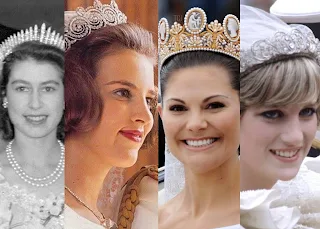




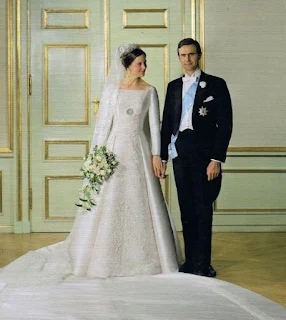



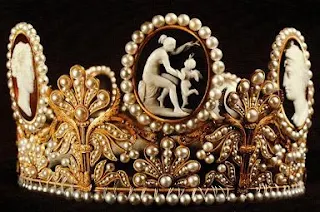









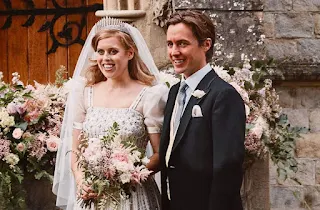




























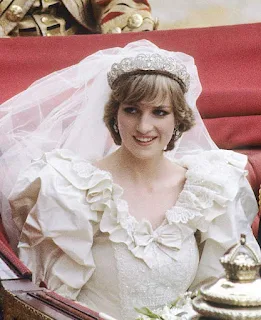

















0 Comments